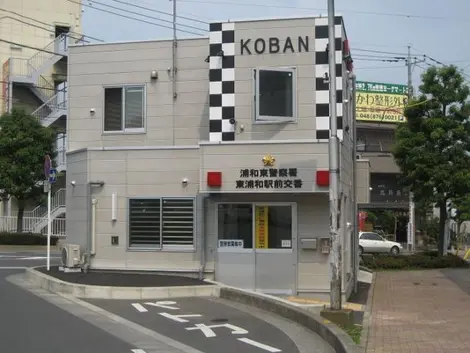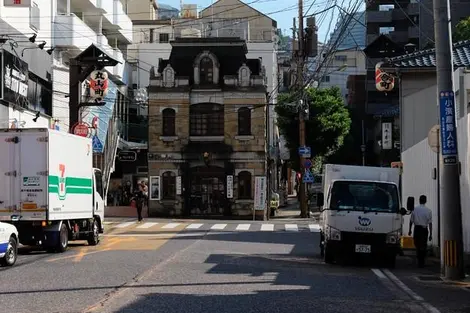Kôban: small community police stations at the heart of public safety in Japan
- Published on : 13/03/2024
- by : C.V
- Youtube
Omnipresent on Japan's busy streets, kôban are small police structures that play an essential role in maintaining order and peace. Discover how these local police stations, present throughout the archipelago, contribute to making Japan one of the safest countries in the world, thanks to their multiple missions in direct contact with citizens.
What is a kôban and how does it work?
Kobans are small neighborhood police stations open 24 hours a day, with a rotating staff of 3 to 10 officers. Attached to a larger police station, there are some 6,000 kôban throughout Japan, including 1,000 in Tokyo alone. Strategically located in high-traffic areas such as railway stations and crossroads, they provide a reassuring, deterrent police presence in the heart of cities.
A true community policing force, koban officers are specially trained to interact with citizens in a friendly, professional manner. Always ready to help, they provide all kinds of practical information with a smile, such as directions or local tips. This daily contact helps to forge close ties with the local population.
Services and missions provided by kôban agents
Much more than mere security guards, kôban police officers carry out a wide range of tasks:
- Patrolling the streets on foot, by bike or by car to prevent crime
- Help people in difficulty (children, the elderly, lost tourists...)
- Receive lost and found and return it to its owner
- Collect complaints and testimonials in the event of minor incidents
- Secure and manage initial findings at crime scenes
- Raising residents' awareness of safety and good neighborliness rules
Thanks to these on-the-ground actions, kôban play a key role in detecting problems early on and maintaining a peaceful climate in neighborhoods. Citizens know they can count on them at all times.
The history and development of kôban since 1874
The first koban appeared in Japan in 1874. Originally, it was a simple wooden box where agents took turns standing guard, hence the name "kô ban" meaning "watchtower". In 1881, these stations were transformed into full-fledged local police stations with a capacity of up to 6 officers.
Over the decades, the kôban system developed throughout the country, adapting to changes in society. Initially focused on surveillance, they gradually turned their attention to prevention and assistance missions. In 1994, their official name was changed back to "kôban", symbolizing their historical roots.
The different types of kôban: small urban stations, chûzaisho, mobile kôban
Although kôbans are often small urban structures, there are several variants:
- Chûzaisho": kôban with housing for agents and their families, in residential areas
- Mobile kôban": fully-equipped vans that travel to areas not covered by the network
- Mini kôbans": for a stronger presence in high-traffic areas (railway stations, shopping centers)
In small kôbans, an intercom system can be used to contact the police if officers are absent. Some of Tokyo's high-tech kôbans are also equipped withtouch-screens displaying information and maps of the area.
What role do kobans play with the elderly and vulnerable?
As Japan's population ages, kôban have become essential to the well-being of isolated elderly people. During their daily rounds, the agents visit the elderly to make sure all is well. They are also there to advise them on the risks of scams that target them.
The growing problem of elderly people suffering from dementia who wander off is also mobilizing the kôban. Working closely with families and social services, they play an active role in locating these people and escorting them safely home. A crucial and reassuring role for many Japanese.
Exporting and adapting the koban model abroad
Since the 1980s, the Japan International Cooperation Agency (JICA) has been helping foreign countries to set up kobans inspired by the Japanese model. Singapore was the first in 1983, followed by Brazil, which adopted this system to secure difficult neighborhoods, notably during major events such as the 2014 World Cup and the 2016 Olympic Games.
Adapted kobans can also be found in the USA (Los Angeles and Hawaii), China, South Korea, Taiwan and Indonesia. While each country adapts the kôban to its own context, the spirit of a police force that is close to its citizens and attentive to their needs is always preserved. A fine recognition for this flagship of Japanese public security.
Why kobans remain an essential part of the Japanese police system
Despite technological advances, kobans remain the indispensable links in a model that has proved its worth in terms of low crime rates. Their effectiveness is based on the high accessibility of their officers, which encourages rapid problem-solving.
Through their reassuring presence in the heart of cities and the countryside, kôban maintain a bond of trust between the police and the population. Every citizen is thus encouraged to adopt a responsible attitude to the safety and peace of mind of all. It's a virtuous circle that contributes daily to making Japan a global benchmark for safety.













